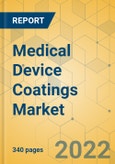Speak directly to the analyst to clarify any post sales queries you may have.
The global medical device coatings market is expected to grow at a CAGR of 6.9% during 2021-2027
With the advent of COVID-19, many scientists started developing novel and eco-friendly surface coating based nano materials from anti-viral and anti-bacterial metal ions and polymers which can prevent surface related SARS-CoV-2 infection.
MARKET GROWTH ENABLERS
- Growing Demand for Antimicrobial Coatings
- Increase In Demand for Minimally Invasive Surgeries
- Technological Innovations in Medical Device Coatings
GLOBAL MEDICA DEVICE COATINGS MARKET SEGMENTS
- Hydrophilic coatings accounted for the highest share of more than 31% in the global medical device coatings market due to its wide application on medical devices for lubricity and compatibility.
- Metallic coatings provide antibacterial properties, durability, compatibility, and other features when coated on medical devices which is contributing to its larger share of around 64.60% compared to non-metallic coatings in the global medical device coatings market.
- Catheters being the most commonly used medical devices in healthcare settings accounted for the major share of over 29% in the global medical device coatings market in 2021.
Segmentation by Coating Type
- Hydrophilic
- Antimicrobial
- Drug-eluting
- Thromboresistant
- others
Segmentation by Material
- Metallic
- Non-metallic
Segmentation of Product
- Catheters
- Implants
- Electrosurgical Instruments
- Stents
- Other
GEOGRAPHICAL ANALYSIS
- In 2021, North America dominated the global medical device coatings market with the highest share of more than 38.00% owing to its large presence of manufacturers, high usage of medical devices, and advancements in medical coatings.
Segmentation by Geography
- North America
- United States
- Canada
- Europe
- Germany
- UK
- France
- Italy
- Spain
- Asia-Pacific
- China
- Japan
- Australia
- India
- South Korea
- Latin America
- Brazil
- Mexico
- Argentina
- Middle East & Africa
- Turkey
- Saudi Arabia
- South Africa
VENDOR LANDSCAPE
- Most of the leading players are focusing on implementing several strategies such as product launches and approvals, marketing and promotional activities, acquisitions, increase in R&D investment, and strengthening their distribution networks to enhance their market share and presence.
Major Vendors
- Hydromer
- Covalon
- DSM
- AST Products
- BioInteractions
- Specialty Coating Systems
- Sciessent
Other Prominent Vendors
- Advanced Industrial Coatings
- Allvivo Vascular
- Avient
- Axalta Coating Systems
- BioCote
- Biomerics
- Carmeda AB
- DOT GmbH
- Endura Coatings
- ENS Technology
- Formacoat
- Freudenberg Medical
- Harland Medical Systems
- Hemoteq addresses
- Isoflux
- jMedtech Coating Technologies
- Merit Medical Systems
- Microban
- Mitsubishi Chemical America (AdvanSource Biomaterials)
- Mitsui Chemicals
- NanoSono’s
- Orchid
- Orion Industries
- Para-Coat Technologies
- Precision Coating Company
- Surmodics
- The Sherwin-Williams Company
- TST
- TUA Systems
- Wright Coating Technologies
- Biocoat
- Corline Biomedical
- Surface Solutions Group
- IST (Integrated Surface Technologies)
- Cytonix
- Medtronic
- Teleflex
Table of Contents
Companies Mentioned
- Hydromer
- Covalon
- DSM
- AST Products
- BioInteractions
- Specialty Coating Systems
- Sciessent
- Advanced Industrial Coatings
- Allvivo Vascular
- Avient
- Axalta Coating Systems
- BioCote
- Biomerics
- Carmeda AB
- DOT GmbH
- Endura Coatings
- ENS Technology
- Formacoat
- Freudenberg Medical
- Harland Medical Systems
- Hemoteq addresses
- Isoflux
- jMedtech Coating Technologies
- Merit Medical Systems
- Microban
- Mitsubishi Chemical America (AdvanSource Biomaterials)
- Mitsui Chemicals
- NanoSono’s
- Orchid
- Orion Industries
- Para-Coat Technologies
- Precision Coating Company
- Surmodics
- The Sherwin-Williams Company
- TST
- TUA Systems
- Wright Coating Technologies
- Biocoat
- Corline Biomedical
- Surface Solutions Group
- IST (Integrated Surface Technologies)
- Cytonix
- Medtronic
- Teleflex
Methodology
Our research comprises a mix of primary and secondary research. The secondary research sources that are typically referred to include, but are not limited to, company websites, annual reports, financial reports, company pipeline charts, broker reports, investor presentations and SEC filings, journals and conferences, internal proprietary databases, news articles, press releases, and webcasts specific to the companies operating in any given market.
Primary research involves email interactions with the industry participants across major geographies. The participants who typically take part in such a process include, but are not limited to, CEOs, VPs, business development managers, market intelligence managers, and national sales managers. We primarily rely on internal research work and internal databases that we have populated over the years. We cross-verify our secondary research findings with the primary respondents participating in the study.

LOADING...








